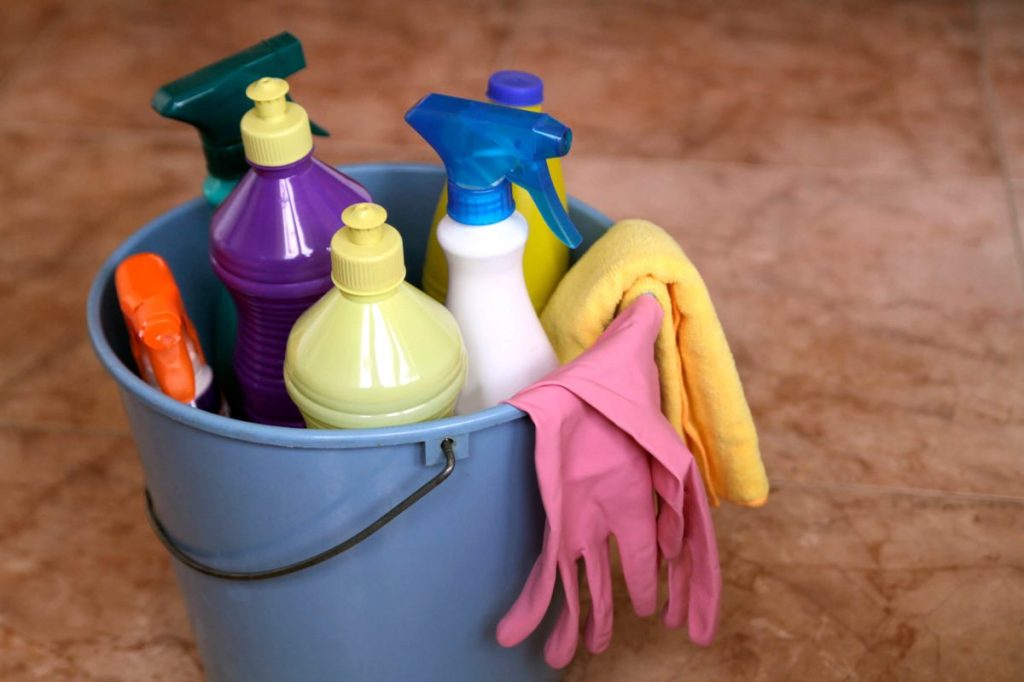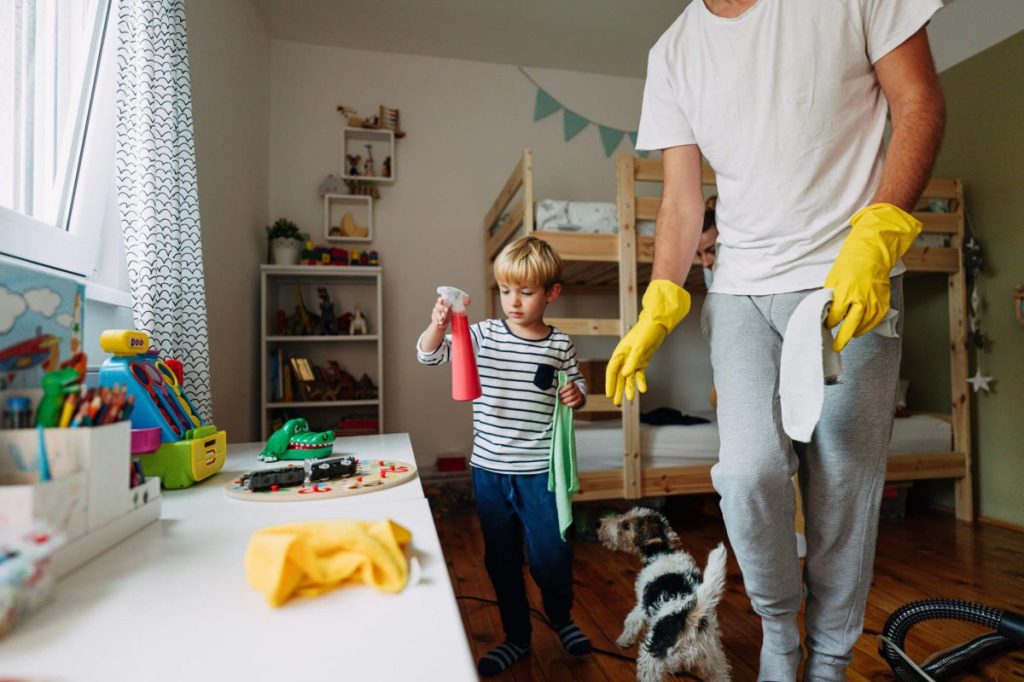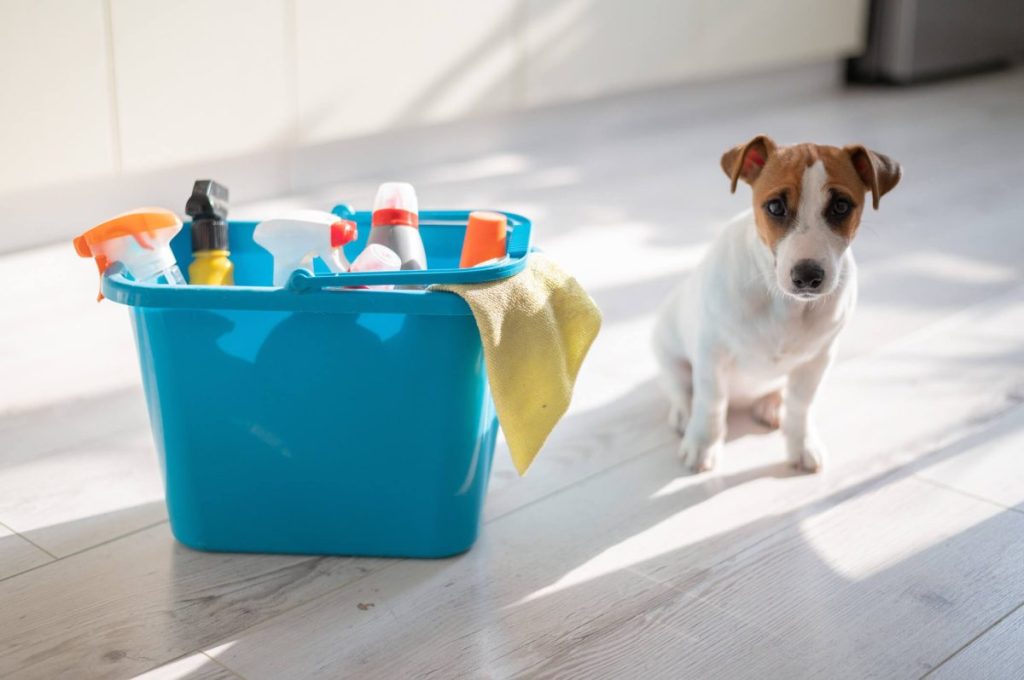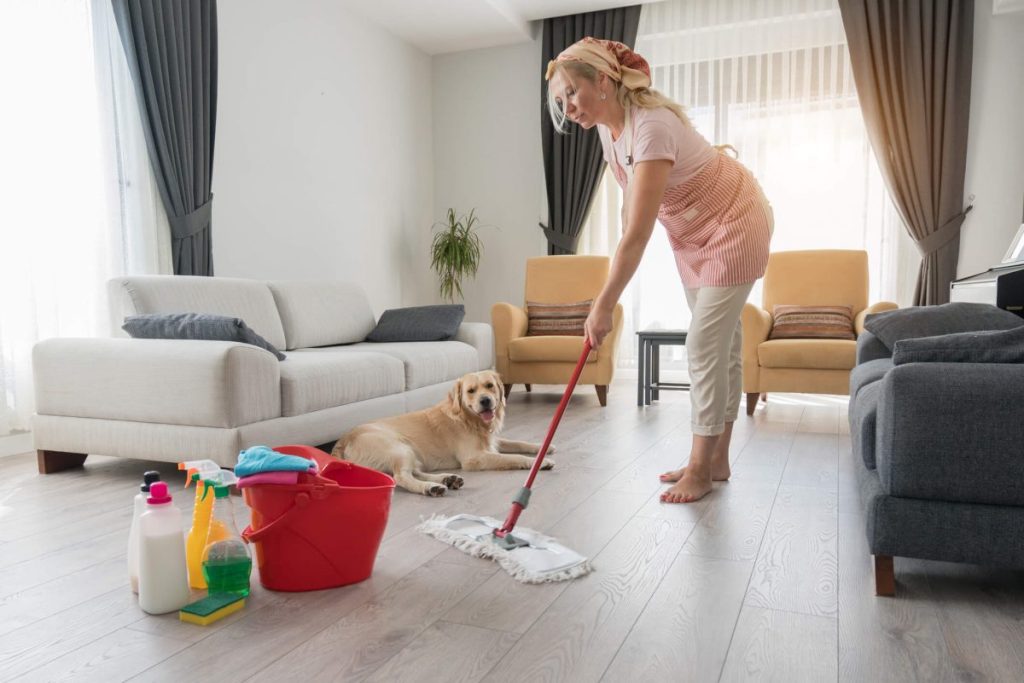For many of us, pets are family. They offer companionship, love, and a sense of responsibility. But let’s face it, they can sometimes turn our homes into a whirlwind of fur, dirt, and little accidents. While it’s important to maintain a clean home, it’s equally crucial to ensure the health and safety of your furry friends. Unfortunately, many conventional cleaning products contain harsh chemicals that can be harmful to pets. The good news is that it’s absolutely possible to achieve a spotless home without putting your dogs and cats at risk. Below, we’ll share some practical tips on how to use pet-safe cleaning products so you can keep everything sparkling while protecting your beloved fur babies.
Why use pet-safe cleaning products?
Before diving into the how, let’s briefly discuss the why. Traditional cleaning products often contain harsh chemicals like ammonia, bleach, and phthalates that can be toxic to pets. These substances can cause a range of health issues, from skin irritations and respiratory problems to more severe conditions like poisoning if ingested. Keep in mind, pets are naturally curious and tend to explore their surroundings with their noses and mouths. This means they are at a higher risk of coming into direct contact with these dangerous chemicals. By opting for pet-safe alternatives, you can ensure that your cleaning routine doesn’t inadvertently put your dog in harm’s way.
What’s more, pet-safe cleaning supplies also contribute to a healthier home environment overall. These products are typically formulated with natural, non-toxic ingredients that are safer for everyone in your household, including young children who may also be prone to contact with floors and surfaces. Plus, they often come with the added benefit of being biodegradable and environmentally sustainable.
What ingredients in cleaning products are harmful to pets?

If you’ve ever noticed your dog sneezing, coughing, or scratching more than usual after cleaning, the products you’re using could be the culprit. Here are some of the most common ingredients found in household cleaners that can be toxic to pets:
- Bleach: Bleach is a powerful disinfectant, but it’s also extremely corrosive. If an animal comes into contact with it, they could experience skin irritation, vomiting, or respiratory issues. Even the fumes can be harmful to your pet’s respiratory system.
- Ammonia: Ammonia is often found in glass cleaners and multipurpose sprays. However, it can irritate your pet’s eyes, nose, and throat. Inhalation of ammonia fumes can also lead to respiratory distress.
- Phenols: Commonly found in disinfectants and household cleaners, phenols can be very toxic to pets. If ingested or absorbed through the skin, phenols can cause liver damage and other serious health issues. Always check the label for ingredients like phenol, carbolic acid, or benzyl phenol.
- Glycol ethers: These are used in many all-purpose cleaners. Glycol ethers can cause respiratory issues and have been linked to liver and kidney damage with prolonged exposure. Products with ingredients like 2-butoxyethanol or ethylene glycol should be avoided.
- Formaldehyde: Formaldehyde is used as a preservative in some cleaning products, but it’s a known carcinogen and can be harmful to both humans and pets. Exposure can lead to respiratory problems, skin irritation, and even cancer over long periods.
- Phthalates: Often found in fragranced cleaning products like air fresheners and dish soaps, phthalates can interfere with your pet’s endocrine system. This can lead to hormone imbalances and reproductive issues.
- Essential oils: While essential oils might sound natural and harmless, some can be toxic to pets. Oils like tea tree, pine, and citrus can cause symptoms ranging from drooling and vomiting to more severe neurological issues.
What cleaning products are safe for pets?

Now that you know which ingredients to avoid, let’s understand what makes a cleaning product pet-safe.
Pet-safe labels
First things first: always read the labels. Many brands now offer products specifically designed to be safe for use around pets. Look for labels that clearly state “non-toxic,” “biodegradable,” or “pet-friendly.” Brands such as Mrs. Meyer’s, Seventh Generation, Method, and Nature’s Miracle are known for their range of pet-safe cleaning products — including disinfectants, detergents, and floor cleaners.
Natural ingredients
Consider using natural cleaning products. Vinegar — both white and apple cider — baking soda, and lemon juice are excellent, pet-safe alternatives for many cleaning tasks. Vinegar mixed with water can handle most surfaces, while baking soda is fantastic for scrubbing and deodorizing. Lemon juice can help tackle tough stains and leaves a fresh scent behind.
DIY cleaning solutions
If you’re a DIY enthusiast, you can easily whip up your own cleaning solutions. For example, a mixture of water and a few drops of mild dish soap can work wonders on most surfaces. Just make sure to thoroughly rinse the area afterward to avoid any soapy residue that your pet might lick up.
Enzyme cleaners
There are also solutions like enzyme cleaners, specifically designed with pets in mind. These products often contain natural enzymes that neutralize odors and break down pet messes like urine, vomit, and feces, making them not only safe but also highly effective at tackling those particularly pet-related cleaning challenges.
How to use pet-safe cleaning products effectively?

Once you’ve chosen the right products, it’s important to use them correctly to ensure maximum safety and effectiveness. Here are some tips to keep in mind while using pet-friendly cleaning products:
Test in small areas first
Before diving into a full cleaning session, test the product in a small, inconspicuous area of your home. This not only ensures that the product is safe for your surfaces but also lets you confirm its safety for your pets. Observe your pet’s behavior and reactions closely when they come into contact with the cleaned area, and discontinue use if you notice any adverse reactions.
Keep pets away during cleaning
While you’re cleaning, it’s best to keep your pets out of the area. Even if the products are pet-safe, the cleaning process itself can be stressful for your pets. Make sure to set up a comfortable, quiet space where they can relax away from the cleaning hustle. This reduces their exposure to any airborne particles and prevents them from stepping on or ingesting any cleaning residue.
Ensure appropriate dilution
When using concentrated pet-safe cleaning products, make sure to dilute them as recommended by the manufacturer. Overly concentrated solutions might not be as pet-friendly as intended. Proper dilution ensures the cleaning solution is effective without posing a risk to your pets. Always use the correct ratio of water to product as specified on the label.
Prioritize high-traffic areas
Pets — especially dogs and cats — tend to frequent certain areas of your home more than others. Focus your cleaning efforts on these high-traffic zones. Steam cleaning is an excellent method for carpets as it uses high temperatures to clean and sanitize, often without any chemicals. For hard floors, choose a mild, pet-safe mopping solution, and rinse thoroughly afterwards.
Be mindful of drying time
Since pets are naturally curious, they may come into contact with freshly cleaned surfaces. After using a pet-safe cleaner, give the area ample time to dry before allowing your dog or cat back into the space. This precaution helps ensure that no residue is ingested or absorbed through their paws. Some products dry faster than others, so always check the instructions for guidance on drying times. To speed up the process, you could leave on ceiling fans or set up a portable fan to help the area dry more quickly.
Wash pet items regularly
Don’t forget to regularly clean your pet’s belongings, such as their bedding, toys, and feeding bowls. Use pet-safe laundry detergents or dish soaps for these items. For toys and dishes, a mixture of warm water and a bit of baking soda can be very effective. Bedding can usually be washed in the machine with a mild, pet-safe detergent. Always rinse thoroughly to ensure no cleaning product residue remains.
Avoid over-wetting surfaces
Pets love to explore, sniff, and sometimes lick surfaces. When using any cleaning product, make sure not to overwet the area. Excess liquid can seep into surfaces and leave behind harmful residues. Use a damp cloth instead of soaking the area and always wipe up any excess product.
Maintain air quality
Air quality is just as important as surface cleanliness, especially if you have pets who shed. Use a pet-safe air freshener to keep your home smelling fresh. Additionally, consider using air purifiers with HEPA filters to trap pet dander and other airborne particles.
Safely store all products
After you’ve finished cleaning, make sure all cleaning products — even if they are pet-friendly — are securely stored away. Curious pets can easily get into bottles and containers, leading to potential poisoning or chemical burns. Keep all products in a high or locked cabinet to avoid any mishaps.
Establish a regular cleaning routine
Consistency is your best friend when it comes to keeping a clean home with pets. Establish a regular cleaning schedule that includes daily, weekly, and monthly tasks. For example, daily tasks might include wiping down pet feeding areas, while weekly tasks could involve vacuuming and washing pet bedding. By staying on top of these chores, you’ll prevent the buildup of pet hair, dirt, and allergens, making your home healthier for everyone.
You can also consult your veterinarian for recommendations on the best pet-safe cleaning products. They can offer valuable advice based on your pet’s specific needs and any health conditions they may have.
What to do if your dog is accidentally exposed to a harmful cleaning product?

Accidents can happen in the blink of an eye, and when it comes to your furry companion, it’s essential to act quickly and calmly. If you suspect your pet has been exposed to a harmful cleaning product, here’s what you can do to navigate the situation effectively.
Stay calm and assess the situation
The first thing you need to do is stay calm. Panicking won’t help you or your pet. Take a deep breath and assess the situation. Look for any signs of distress in your dog, such as excessive drooling, vomiting, difficulty breathing, or lethargy. These symptoms can vary depending on the type of cleaning product and the amount of exposure.
Remove your pet from the source
Quickly but gently remove your pet from the area where the exposure occurred. Make sure they don’t have any more contact with the harmful substance. If the product was spilled, clean it up immediately to prevent further exposure to both your pet and other household members.
Check the product label
If possible, take a moment to read the label of the cleaning product. Many products have emergency instructions or a hotline number that you can call for immediate advice. Take note of any specific warnings or recommended first-aid measures mentioned on the label.
Rinse and clean
If the cleaning product is on your pet’s fur or skin, gently but thoroughly rinse the affected area with lukewarm water. Avoid using hot or cold water as extreme temperatures can exacerbate the situation. If the product is particularly sticky or oily, you may need to use a pet-friendly shampoo to remove it completely. Be sure to avoid getting the substance in your pet’s eyes, ears, or mouth during this process.
Do not induce vomiting — unless advised
If your pet has ingested the cleaning product, do not induce vomiting unless instructed by a veterinarian or a pet poison control expert. Some substances can cause more damage coming back up, so it’s important to follow professional advice.
Contact your vet
Reach out to your veterinarian immediately, even if your pet seems fine. It’s always better to be safe than sorry. Provide them with as much information as possible: the type of product, how much was ingested or contacted, and any symptoms your pet is displaying. Your vet will be able to guide you on the next steps and may recommend bringing your pet in for an examination. Follow through with their advice and any prescribed treatment plans, which may include activated charcoal, IV fluids, or specific medications to counteract the toxins.
If you can’t reach your vet, contact the ASPCA Animal Poison Control Center (APCC) at (888) 426-4435 for help.
Your pet relies on you for their safety and care. Incorporating pet-safe cleaning products into your routine is a simple yet impactful way to ensure the well-being of your furry friends. So, the next time you’re stocking up on cleaning supplies, take a moment to check labels and opt for pet-friendly options. Remember, when in doubt, always consult your veterinarian. It could save your dog’s life.









